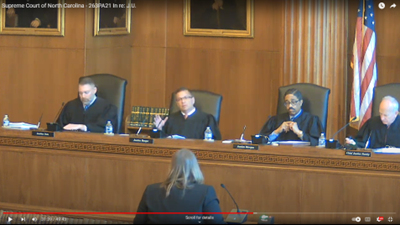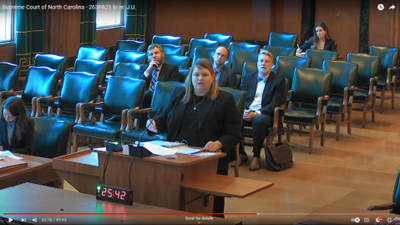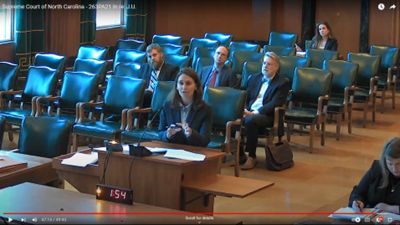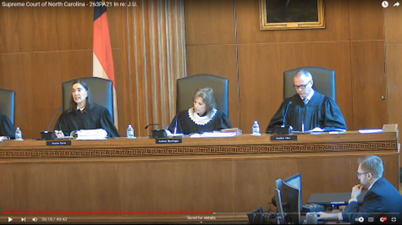
Happy Friday, readers! It's been quiet in the appellate courts in the juvenile delinquency world, and with no new cases to update on, it's been a little quiet in the Case Law Corner as well. Time to break the silence!
Recently, I had the privilege of a glimpse into the preparation of a case for oral argument. Heidi Reiner, Assistant Appellate Defender at the Office of the Appellate Defender, was preparing for oral argument in a Cumberland County Delinquency appeal, In re: J.U., 2021-NCCOA-323, and offered me a place at the table during a moot session she was holding prior to oral arguments at the Supreme Court. I can’t say I 100% knew what a moot session was, but my guess was correct: a trial run with colleagues in which she practiced answering questions posed by those colleagues as if they were the Justices at oral argument.
Procedural History of the Case: The child was adjudicated delinquent of sexual battery and simple assault in Cumberland County in 2020, with a Level II disposition imposing 12 months of probation. The juvenile appealed to the Court of Appeals, alleging:
The petition for sexual battery was fatally defective in failing to allege the necessary element of force;
The State failed to present sufficient evidence of all elements of sexual battery;
Trial counsel committed per se ineffective assistance of counsel in conceding guilt to simple assault without the proper Harbison inquiry;
The disposition order lacked findings of fact sufficient to support the punishment imposed.

The NC Court of Appeals held (in an unpublished opinion) that (1) the petition for sexual battery was in fact fatally deficient and vacated the adjudication order. In turn, the disposition order was vacated, rendering issues (2) and (4) moot. The court remanded for an evidentiary hearing on issue (3) above. On remand to the trial court, the State dismissed the simple assault allegation, rendering the IAC claim (issue 3) moot. The State appealed the Court of Appeal’s decision in regard to the petition being fatally deficient. The child has since completed his probation and probation was terminated successfully.
The question presented on appeal to the Supreme Court and that we addressed during the moot was whether failure to allege the element of force explicitly in the petition rendered the petition fatally deficient, and alternatively, if so, whether that is a jurisdictional issue. Specifically, the petition alleged that the child did unlawfully “engage in sexual contact with [the victim] by touching [the victim]’s vaginal area, against the victims [sic] will for the purpose of sexual gratification.”
On its face, it’s very clear that the petition does not allege the element of “force” nor any facts to support that element. Where it gets interesting is the state’s argument that the element of force is actually alleged through the use of the combination of “unlawfully” and “against the victim’s will,” which, according to the State, sums up to or amounts to the equivalent of force. I did learn a new word during my explorations of this argument: subsume (“to include or place within something larger or more comprehensive; encompass as a subordinate or component element”). Essentially, the state argued that the element of force was subsumed by the other language in the petition. The strongest argument the state seemed to have, and that the Court was eager to ask questions about, was State v. Johnson, 226 N.C. 266 (1946) (referred to in the oral arguments as “Johnson II”), which wrote that the term forcibly “can be supplied by any equivalent word” and “is sufficiently charged by the words ‘feloniously and against her will.” Id. The juvenile’s response was that this phrase from the opinion was dicta and that the there were in fact other terms in that case that all together were sufficient to allege force, as well as the fact that the case was from 1946 and an example of archaic linguistics. Id.
It was very interesting to watch the process go from the conference room at the Appellate Defender’s office to the courtroom at the Supreme Court. In the conference room, there were questions from the mock Justices as well as commentary, discussion, note taking, flipping through code books, and more discussion. Dressed for a day at the office, Heidi answered the questions posed in the conference room with a generally laid-back style, taking notes on additional topics she would want to research further, and flipping through case law to find the right quote. When I tuned in to YouTube to watch the live stream of the oral arguments, Heidi had donned a sharp black suit and commanded the attention of the courtroom, answering the Justice’s questions with authority and nothing short of sharp wit. It was inspiring to watch her argue her client’s position and explain and educate her audience.
At oral arguments, the State argued first as the appellant. Of the seven Justices hearing the arguments, five Justices posed questions to the State, including asking whether it was essentially the State’s contention that the “by force” language in the petition was unnecessary, and whether the phrase “unlawfully” could cover other terms as well. Justice Morgan commented on the difference between “vernacular” and “statutory requirements,” specifically using the phrase “exacting standards.” As Heidi argued for the Appellee, she was immediately presented with a question as to the difference between an indictment and a petition. In total, all but Justices Newby and Berringer asked questions of the attorneys throughout the hour of oral arguments.
I am eager to see what the ultimate outcome of the case is when the Court issues its opinion. Until then, check out the oral arguments on the NCSC YouTube channel and let us know your thoughts or predictions of the outcome! https://www.youtube.com/live/HqMqqgKRxFI?feature=share








